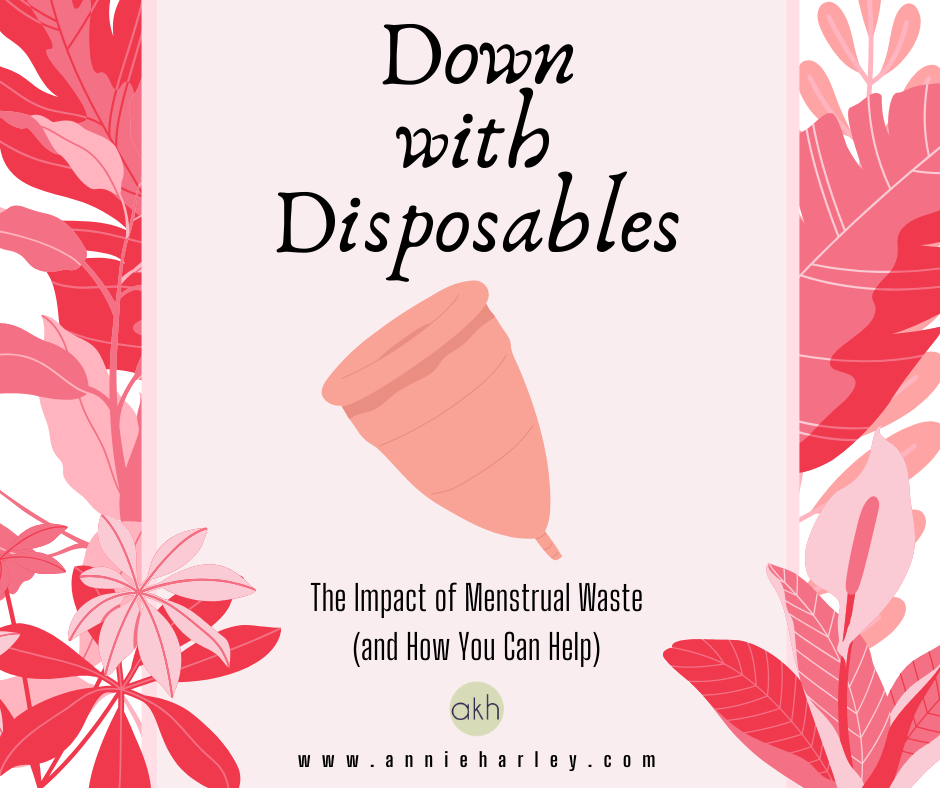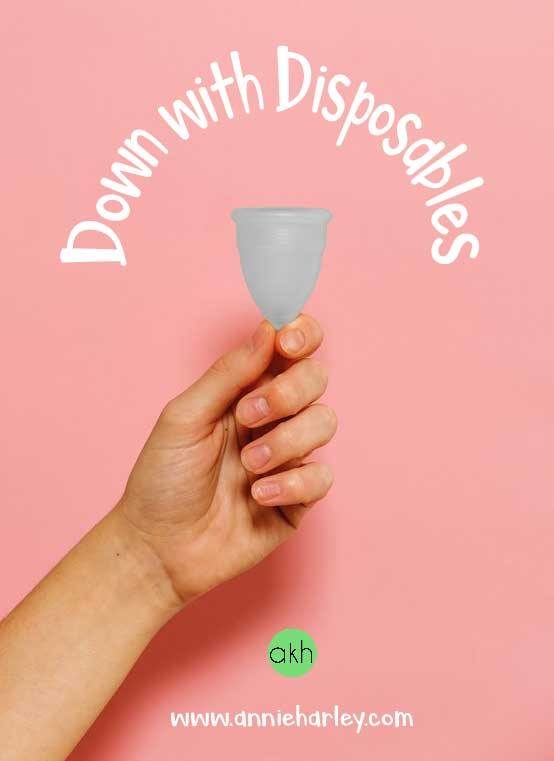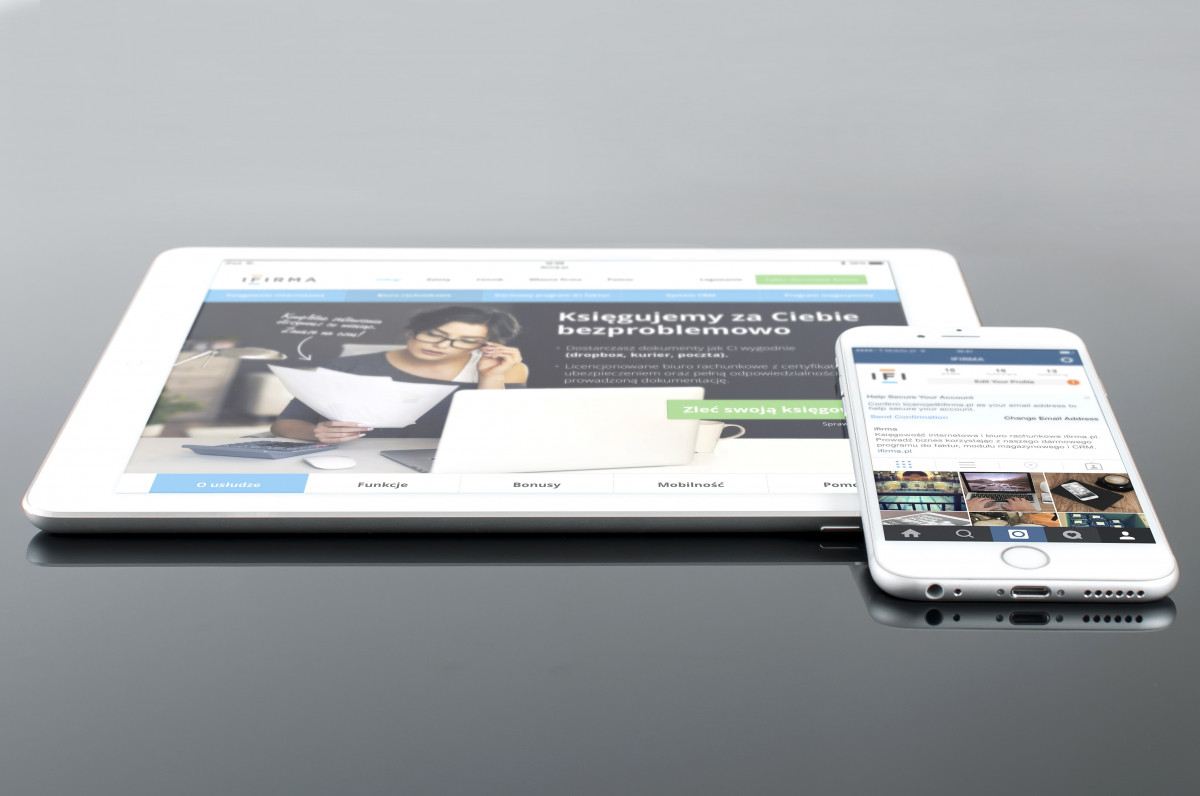
When looking into the health aisle of almost any store, you will find a wide array of colorful packages of tampons and pads. Regular, super, plus, with wings… these products come in several sizes and absorbencies. It’s safe to say that pads and tampons dominate the market for menstrual care; they are by far the most well-known means for dealing with monthly periods. However, this does not mean that these products are the only or the best ones available. Quite the opposite is true. Pads and tampons are not only bad for the environment, but they are bad for you!
Menstruation has, quite obviously, been around as long as humans have. Women have come up with a variety of ways to deal with bleeding throughout history. Before pads and tampons were sold, women had to get creative. Rags, cotton, sheep’s wool, knitted pads, rabbit fur, even grass were used to hand our ancestors’ monthly flow. Commercial sanitary pads were first sold in 1888 preceding tampons by 42 years. (Sabrina, 2016) Commercial tampons were first introduced to the United States public in 1930; their design has remained almost the same since the original release. (Schopick, 2017) Neither the pad and the tampon were originally intended for collecting menstrual blood. The first ‘pads’ were bandages made in France. Nurses cultivated them from a wood pulp material to help staunch blood flow from battle wounds. Eventually, they began using them for menstruation, and before long pads were commercialized. (Sabrina, 2016) The concept of a tampon has been used for several centuries. Ancient Egyptians took advantage of the papyrus plant while World War I nurses altered extra bandages to deal with their flow. (Kennedy, 2016) The mere idea of pads and tampons is ancient; they just weren’t designed with mensuration in mind but simply adapted from other products. Unfortunately, these archaic designs come with an array of overlooked health risks.
Despite its innocent external appearance, a tampon is not exactly harmless. SafeCosmetics.org says “tampons may contain traces of dioxin from bleach, pesticide residues from conventional, non-organic cotton, and mystery ‘fragrance’ ingredients.” (Safecosmetics.org, n.d.) Yuck. Why do we need an internal fragrance, anyways? Fragrance, along with those questionable ingredients, is just as unsafe as it sounds. According to Science Direct, dioxin is a carcinogen that has been tied to type II diabetes, endocrine disruption, heart disease, cancer, and skin disease. (Hait & Powers, 2019) Double yuck. It is incredibly unsafe to expose such a sensitive body part to these chemicals. Unfortunately, we may never have a comprehensive list of the components used in manufacturing. Menstrual pads and tampons are considered to be medical products, so manufacturers are not legally required to document all of the materials used in their production. (Hait & Powers, 2019)
Women began to question the safety of tampons when the first cases of Toxic Shock Syndrome (TSS) appeared in the 1970s. TSS is particularly associated with larger, or “super,” tampons. (Hait & Powers, 2019) The looming risk of TSS is why women must be careful to change their tampon every four to eight hours. “TSS is a rare but serious bacterial illness. In the U.S.,” says Erin Clark, MD, obstetrician-gynecologist. “TSS is estimated to affect three to six people per 100,000 per year,” (Mitchell, 2018) Though the risk of TSS is low, it is still a fatal illness that could develop with tampon usage.
While the possibility of TSS costing a woman her life is relatively low, the price of menstruation is not. In her lifetime, a woman will use anywhere from 8,000 to 17,000 pads and tampons. (Wood, 2016) How much will a woman have to pay for coverage during her period overall? If a woman buys a box containing 20 tampons or pads for each menstrual period at $5 per box, she’ll be spending anywhere from $2,000 to $4,250 on single-use products in her lifetime. This number will vary from woman to woman depending on several factors including (but not limited to) period length, cost of products, and how many sanitary products she goes through. This doesn’t include purchases like pain relievers, new undergarments, additional toilet paper, and even snacks. Menstruation is not cheap.
Disposable sanitary pads and tampons are not only bad for your body and wallet; they are (unsurprisingly) horrible for the environment. The average menstruating woman will discard up to 300 pounds of feminine hygiene-related products (pads, tampons, wrappers, applicators, boxes, etc.) in her life. In the United States, 12 billion pads and 7 billion tampons are disposed of every year. (Schopick, 2017) Why should we waste so much on single-use products?

Several reusable menstrual products are on the market that will allow you to escape the expensive and dangerous issues associated with pads and tampons. These reusable alternatives are chemical-free, not linked to TSS, won’t cost a fortune, and will greatly reduce your carbon footprint. One of the most popular eco-friendly options is the menstrual cup. Most cups are made of medical-grade silicone and have a distinct bell shape. Cups can be worn for up to 12 hours (depending on the heaviness of your period) between emptying. (Eijk & Zulaika et al., 2019) Despite their recent increase in popularity, menstrual cups aren’t new. The modern-day menstrual cup was patented in 1937 by a woman named Leona Chalmers. However, because of WWII, rubber was in high demand making production nearly impossible. After the war, Chalmers tried to sell menstrual cups again but it didn’t take off; this was largely due to the taboo surrounding periods. (Intimina, 2015)
Using a cup rather than tampons has actually been proven to lower the risk of TSS. With cups there 2.25 cases out of 100k rather than tampons with 3-6 cases out of 100k. Cups have other benefits over tampons: they do not absorb the natural moisture of the vagina. (Put A Cup In It, 2017) Additionally, a Kenyan study discovered “lower bacterial vaginosis in users of a menstrual cup than in those who used sanitary pads,” which means that “the material of the menstrual cup might assist in maintaining a healthy vaginal pH and microbiome.” (Eijk & Zulaika et al., 2019) Another potential benefit is that there has been anecdotal evidence suggesting that using cups can decrease cramps! (Galan, 2019)
Compared to disposable products, menstrual cups will save you a noticeable amount of money. One cup can cost anywhere from $15 – $40 dollars. While that may be much more than a $5-dollar box of tampons, a menstrual cup can last up to 10 years with proper care. (Eijk & Zulaika et al., 2019) Those $5-dollar boxes can add up fast but with menstrual cups, you will only need one. With the money saved from ditching disposables, you can fill up your bank account rather than the landfill.
That being said, giving reusables a try could lead to an enormous decrease in menstrual waste. If just one woman switched from disposables, the result would be 300 pounds less waste a year. In a study on mid-point climate change and menstrual products, the menstrual cup was found to have less than 1.5% of the impact tampons or pads had (which were the most impactful of those studied) in each category examined. (Hait & Powers, 2019) Menstrual cups can change the fate of the environment.
Despite the many wonderful things about menstrual cups, some women are not convinced. Reasons for the aversion range from being uncomfortable with one’s body, skepticism, upfront cost, worried it ‘won’t work for me,’ and repulsion at the concept.
Many women grew up in a home where menstruation was kept secret, treated as disgusting, and rarely spoken of. Attitudes like this can often lead to one being uncomfortable with the closeness required for the insertion. Trying menstrual cups could be looked at as a way to become acquainted with one’s body. It could be an attempt to understand that menstruation isn’t ‘gross,’ but rather a bodily function. Others wonder if the menstrual cup really is all its chalked up to be. Hearing about a tampon alternative that boasts 12 hours between changes, lowers the risk of TSS, and claims to save you money does seem a little unrealistic. However, a little research is bound to validate claims surrounding the menstrual cup. Alternatively, asking any cup user if it’s worth it is always a great way to confirm or disprove your suspicions.
Many women have expressed fears of not wanting to spend the money on a cup that she may not like. It’s a valid fear; spending around $30 dollars on a cup seems like a big leap for something you may not use. Some brands will offer a refund if your cup doesn’t work for you, but that is not always the case. Thankfully, there is a sort of ‘safety net’ with cups; it has been proven safe to resell a used menstrual cup. (Put A Cup in It, 2019) Just request the seller to boil the new-to-you cup before shipping and boil again upon arrival. This effectively kills any germs, bacteria, STIs, and STDS that could have been present on the cup. Though some people aren’t comfortable with using someone else’s old cup, there are plenty of women in buy, sell, and trade groups who would be eager to take your cup off your hands.
For those who state that menstrual cups just don’t work for them, odds are that they’ve tried the wrong cup. For example, some first-time users experience discomfort, leaking, and the inability to get their cup to open, among other things. For someone who has invested a bit of money into the supposed ‘miracle tampon alternative,’ this can be rather disappointing and frustrating. After a bad cup experience, one may be tempted to give up and go back to tampons with the belief that cups just don’t work. This is not necessarily true. No vagina is the same, so there simply cannot be a one-size-fits-all menstrual cup. Like tampons and pads, there are a variety of cups available. When deciding on the right cup, a few things a woman should take into consideration are her cervix height, if she’s given birth, how heavy her flow is, and her activity level, to name a few. All of these pieces of information are important to consider when choosing the perfect cup.
If you’re feeling a little lost, don’t worry! Put A Cup in It (PACII), an online resource founded in 2015 for all things menstrual cup related, has developed the “Cup Quiz.” After answering nine questions, are provided with suggestions for cups that could work well for you. While the match isn’t guaranteed to work for everyone, PACII boasts that 88% of women surveyed found their perfect cup through the quiz. (Put A Cup In It, 2017) The quiz is certainly a useful resource for a woman who doesn’t know where to start on her journey to a waste-free period.
Open discussion about mensuration options and intimate health is something women should not take for granted. In the 1920s, women purchasing pads were encouraged to take the package themselves and place the payment in a box so they did not have to speak to the cashier. (Sabrina, 2016) Total period secrecy may be a thing of the past, but this mindset has caused a lot of women to feel disgust or shame associated with menstruation. Menstruation is a natural bodily function. It’s true that periods aren’t the most pleasant topic of discussion, but, let’s be real: neither are any other bodily functions.

Menstrual periods can be a physical, environmental, and financial pain. Fortunately, they don’t have to be. Thanks to menstrual cups, women can now experience a leak-free (when used correctly), toxin-free, waste-free, and a financially freeing period. Switching to reusable products can not only change a woman’s period, but it can change the world. If reusable products become mainstream, a virtually waste-free period could happen. This is only step one: all disposable products need to become a part of the past. Disposable forks, plates, wrappers, diapers, and so many other products are being used once and tossed to the wayside. It may be convenient right now, but before long, we will be unable to clean up the messes our ancestors made in the name of convenience. If we don’t begin right now in taking responsibility for our messes and using eco-friendly alternatives, the Earth will be too far gone. Save a tampon and try on a cup for size: The Earth will thank you.
By Annie Harley
Interested in trying a cup? Check out the Lily Cup or the Lunette Cup!
Work Cited:
Cumulative Exposure And Feminine Care Products. (n.d.). Retrieved February 28, 2020, from http://www.safecosmetics.org/get-the-facts/healthandscience/cumulative-exposure-and-feminine-care-products/
Eijk, A. M., Zulaika, G., Lenchner, M., & Mason, L. (2019, July 16). Menstrual cup use, leakage, acceptability, safety, and availability: a systematic review and meta-analysis. Retrieved February 28, 2020, from https://www.thelancet.com/journals/lanpub/article/PIIS2468-2667(19)30111-2/fulltext
Hait, A., & Powers, S. E. (2019, August 19). The value of reusable feminine hygiene products evaluated by comparative environmental life cycle assessment. Retrieved February 28, 2020, from http://www.sciencedirect.com/science/article/pii/S0921344919303179
Hearn, A. (2019, September 30). And The Study Says: Menstrual Cups Are As Safe & Effective As Other Options! Retrieved February 28, 2020, from https://putacupinit.com/menstrual-cup-study/
Holland, K. (2018, May 30). How Much Blood Do You Lose on Your Period? Retrieved February 28, 2020, from https://www.healthline.com/health/how-much-blood-do-you-lose-on-your-period
Phipps, S. (n.d.). Comfortable with Their Bodies: Menstruation, Culture and Materialism in America. Retrieved February 28, 2020, from https://scholarworks.gsu.edu/anthro_hontheses/8/
Put A Cup In It. (2017, September 26). What IS A Menstrual Cup? We’re so glad you asked… Retrieved February 28, 2020, from https://putacupinit.com/what-is-menstrual-cup/
Schopick, J. (2017, July 27). The Environmental Impact of Everyday Things. Retrieved February 28, 2020, from http://www.thechicecologist.com/green-living/the-environmental-impact-of-everyday-things/
Why Switch? (n.d.). Retrieved February 28, 2020, from https://lunapads.com/pages/why-switch?geoip_country=US
Wood, L. (2016, September 18). A menstrual cup? Is that what is sounds like? Gross. Retrieved February 28, 2020, from https://theecoguide.org/menstrual-cup-what-sounds-gross
Sabrina. (2016, November 24). The History of the Sanitary Pad. Retrieved February 28, 2020, from https://www.femmeinternational.org/the-history-of-the-sanitary-pad/
Intimina. (2015, March 6). The History of Menstrual Cups: INTIMINA. Retrieved February 28, 2020, from https://www.intimina.com/blog/history-menstrual-cup/
GladRags Learn About Cloth Pads & Menstrual Cups. (n.d.). Retrieved February 29, 2020, from https://gladrags.com/pages/questions-about-menstrual-cups-cloth-pads-answered
The History of Tampons: SexInfo Online. (2018, October 16). Retrieved March 1, 2020, from https://sexinfo.soc.ucsb.edu/article/history-tampons
Kennedy, P. (2016, April 1). The Tampon of the Future. Retrieved March 1, 2020, from https://www.nytimes.com/2016/04/03/opinion/sunday/the-tampon-of-the-future.html
Mitchell, L. (2018, July 2). What You Need To Know About Toxic Shock Syndrome. Retrieved March 1, 2020, from https://healthcare.utah.edu/healthfeed/postings/2018/07/tss.php
Put A Cup In It. (2017, September 26). What is a Menstrual Cup? Retrieved March 2, 2020, from https://youtu.be/hqQreZj3Zeg
Put A Cup In It. (2019, October 7). Menstrual Cup FAQ [& some not so frequently asked] by Put A Cup In It. Retrieved March 2, 2020, from https://putacupinit.com/faq/#buying
Galan, N. (2019, May 2). Menstrual cups: Everything you need to know. Retrieved March 3, 2020, from https://www.medicalnewstoday.com/articles/325093#pros







